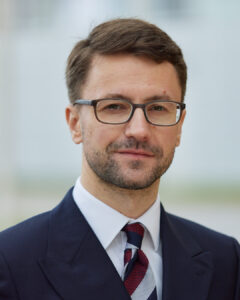Iaroslav Meleshenkovskii’s Interview
Starting date: 01.09.2022
Nationality : Russian
Implementing Partner : Jülich Center for Neutron Science
Main supervisor: Dr. Eric Mauerhofer

Few words about you and your research project
I am a nuclear physicist specializing in applied nuclear metrology. I received my PhD from Université libre de Bruxelles and SCK-CEN in Belgium. Then I joined Commissariat à l’énergie atomique et aux énergies alternatives (CEA) in France.
The project I proposed within GNeuS, and that was selected within Call n.1, is devoted to development of a fast neutron inelastic scattering technology for non-destructive characterization of rare-earth elements in magnets. The major scientific method to carry out the research is based on experimental activities with the FaNGaS (Fast Neutron induced Gamma-ray Spectrometry) instrument installed at the Heinz Maier-Leibnitz Zentrum (MLZ) in Garching, compact neutron sources developed by the project secondment Dynaxion (Netherlands) and Monte Carlo simulations.
The project is hosted by Jülich Center for Neutron Science and supported by industrial partners, such as Fraunhofer IWKS and AixACCT System GmbH.
What is your background? How have you heard about GNeuS?
I have a background in different domains of applied nuclear metrology. During my career in prominent universities and research institutions I have acquired knowledge and expertise with various passive and active non-destructive assay methods (X- and gamma-ray spectrometry, neutron interrogation, photofission), particle accelerator technologies, detection methodologies, neutron and X- and gamma-ray detectors, Monte Carlo simulations.
During my PhD project at Université libre de Bruxelles and SCK-CEN, I developed two codes (MCSIGMA and CAMILA) for determination of uranium and plutonium isotopic composition, as well as different algorithms for X- and gamma-ray spectra analysis. At CEA, I worked on the EU H2020 project MICADO devoted to designing of a mobile LINAC-based system for characterization of nuclear waste packages by non-destructive photofission assay technique. A summary of my research can be found by this link.
I was informed about the GNeuS program and opportunities by Dr. Eric Mauerhofer, whom I know from his joint work with CEA.
Why did you apply specifically on GNeuS?
I decided to candidate for the GNeuS Call n.1 as I wanted to continue my development as an expert in the domain of applied nuclear metrology.
The GNeuS programme offers a possibility to acquire new knowledge and skills. It is also ideal for me to make a contribution and promote application of neutrons in industry and science.
What impacts do you expect from the GNeuS fellowship?
Within GNeuS, I expect improving the portfolio and sustainability of neutron technologies by developing a fast neutron inelastic scattering analytical technique that will allow tackle the existing challenges and address the industrial needs, such as fast characterization of bulk magnet samples in view of their recycling. Such tasks represent a strategic importance because rare-earth magnets are a critical component of modern technologies (e.g. energy systems, electric and hybrid vehicles, consumer electronics etc.).
The planned activities include participation to conferences in the domain of radioanalytical techniques and accelerator applications, dissemination of the achieved results in peer-reviewed publications, fostering of the Interdisciplinarity and Intersectorality of the research, as well as collaboration with industrial partners. The proposing fast-neutron based technology can be extended to other potential domains, such as homeland security (detection of illicit/dangerous objects in freight cargo) for which fast-neutron based non-destructive analysis techniques represent a promising solution to interrogate voluminous objects and extract an array of qualitative and quantitative information. This pushes forward the neutron-based technology, its applications in various markets and fosters sustainability in neutron science.
